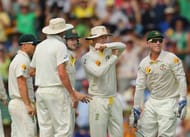The third umpire takes his time, analyses a pending matter from all angles and then gives his decision. The on-field umpires actually face the real music as they have to deliver decisions in a matter of seconds and that too with no technological help.
The concept of third umpire is in a way very ironical. Except the players and umpires involved in a particular match, all others can watch the match very closely. They can even notice the strong zones and weak zones of batsmen, ball tampering, etc. The irony doesn't end here. With the advent of third umpires, which is actually better than the two on-field umpires, the notion "Umpire's decision is final" has taken a major hit.
Even the third umpire has been under an evolution process in the last few years with the concept of DRS (Decision Reviewal System) coming onto the international arena. DRS is a rule through which if a player unsatisfied with the on-field umpire's decision can ask for its reviewal from the third umpire.
If the third umpire sees that the on-field decision is wrong, he can overturn it otherwise it stays the same. Although the concept and motive behind DRS seems pretty fair, the system has had its own share of mistakes. Some decisions in the recent past have gone horribly wrong even after the use of DRS. This has created doubts in the minds of players and spectators over the credibility of this newly introduced advancement. All in all, the longevity of DRS is a topic under consideration.
A high stake sport needs a greater accuracy in decisions. The advent of televisions and slow motion replays really undermined the authority of umpires. Hence, the need of third umpires in this high growth era is greater than ever. Even though the system is fault free, a helpful advancement in the current system, if found, is of no harm.
Looking for fast live cricket scores? Download CricRocket and get fast score updates, top-notch commentary in-depth match stats & much more! 🚀☄️

